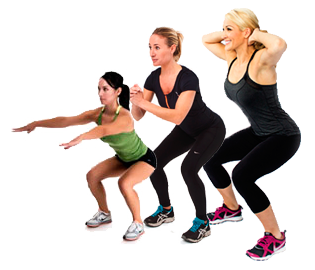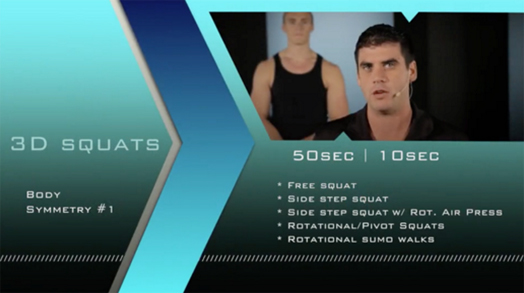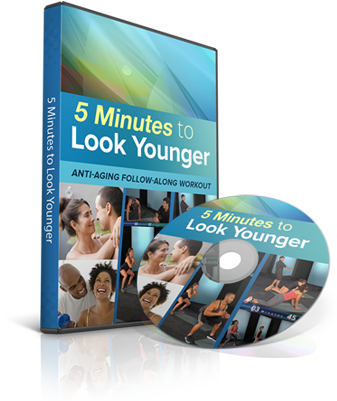
Our bodies are designed to be able to lift heavy objects, move them, and place them back down. We are designed to be able to bend over, stand up, walk, step, jog, run, and hike. Perhaps the most powerful and effective exercise to train for all of these environments is the squat.
Before I go on, I'd like to address a few of the most common myths surrounding squats:
-
Myth #1: If you squat, you get huge.
Most people make the mistake of thinking squats are for people who want to grow huge muscles; while squatting is effective for muscle building, learning how to squat with your bodyweight alone is enough to gain all of the functional and health benefits, without any increase in muscle size. If you want to grow muscle, simply add weight, reduce reps, stack exercises, and increase rest periods. -
Myth #2: Squatting only builds leg strength and endurance.
Squatting is a whole body exercise. The way your chin lines up over your shoulders matters in order to keep your spine aligned. The way your knees line up over your toes will allow you to build strength in your legs, hips, calves, and core. If you squat with weight, you'll build strength in your upper body as well, especially as you test out new movements, like squats with rotational presses, where your upper body is involved in the exercise. -
Myth #3: Squatting is hard on joints (knees, hips, ankles, etc.).
This couldn't be further from the truth; however, squatting 'improperly' will certainly destroy knees, hips, ankles, and even low backs. Biomechanically speaking -- or the way our muscles line up with our joints -- squatting is one of the most effective ways to stabilize, lift heavy objects, and move -- without any joint damage. This is why it's so important to learn how to squat well; the same exercise that destroys joints can 'save' them when done with proper form. -
Myth #4: Squatting is bad for people with low back pain.
In actuality, squatting is one of -- if not the -- most effective ways to build core strength. And core strength is one of the most important factors to get rid of low back pain. Other important factors include: hip flexor mobility/flexibility, hamstring strength, calf strength, low back mobility, mid-back mobility, muscle sequencing, and proper form with activities. The good news is: squats help with all of these things. -
Myth #5: You can't get a six pack from squats.
Your abs primary functions are: bend at the waist, twist/turn, compress abdominal contents, stabilize spine and pelvis, and increase intra-abdominal pressure to protect vital organs.Functionally, your abs work throughout the day every time you reach and grab something above your head, bend down to pick up an object, sit down into a chair or stand up, get on/off the ground, or do just about any form of exercise. Due to your abs job of stabilizing your spine and pelvis, they are involved in almost every activity you do throughout the day.
And, the more pull there is on your spine and pelvis, the harder your abs will work. Well, squatting is exactly that: strain on the spine and pelvis, as you move from a standing to bent-over position. If you add an upper body movement or twist, like in Side Step Squat With A Rotational Air Press, you are targeting even more of your abs.
The fact is, you'll get a six pack much faster doing exercises like squats, deadlifts, lunges, presses, and pull ups than you ever will doing sit-ups, crunches, or cardio.

Now that you understand how misunderstood squats really are -- and how important they are to help you look and feel great from exercise -- it's time to go over form. We're going to take a look at 5 different types of squats:
1.) Free Squats:

Instructions: Stand feet shoulder width apart or slightly wider, squat down and into your heels while lightly contracting your abs, and squeeze your cheeks to stand up. Level one is hands at your side, level two is arms across your chest, and level three is fingertips at ears.
2.) Side Step Squats:

Instructions: Stand feet together, step to your right side -- so your feet are about shoulder width apart or slightly wider -- and squat down into your heels while lightly contracting your abs. Squeeze your right cheek to stand up, as you take all the weight off your left foot. Come back down onto your left foot and repeat on the opposite side.
3.) Side Step Squats With Rotational Air Press:

Instructions: Stand feet together, step to your right side -- so your feet are about shoulder width apart or slightly wider -- and squat down into your heels while lightly contracting your abs. Squeeze your right cheek to stand up, as you take all the weight off your left foot. While standing, reach up and towards your right side with your arms, as if you're holding a ball overhead at the top of the exercise. Come back down onto your left foot and repeat on the opposite side.
4.) Rotational Pivot Squats:

Instructions: Stand feet together, turn and squat so you're now facing 90 degrees to the right. Be sure to land such that your feet are about shoulder width apart, or slightly wider, and you're lightly contracting your abs. Squeeze your left cheek to stand up, pivot and return to the starting position, as you take all the weight off your right foot.* Alternate.
*SAFETY NOTE: In pivot squats, pay special attention to keep your knees over your toes at all times. This means your knee does not pivot while your foot is on the ground. Instead, it stays aligned in the same direction as your toes.
5.) Rotational Sumo Walks:

Instructions: Squat down until your knees and hips are at 90 degrees, and your weight is in your heels. Now rotate 180 degrees by completely de-weighting your right leg and pivoting on your left leg.* Return to the starting position and rotate in the opposite direction, while squatting throughout.
*SAFETY NOTE: In sumo walks, pay special attention to keep your knees over your toes at all times. This means your knee does not pivot while your foot is on the ground. Instead, it stays aligned in the same direction as your toes.

These five exercises were taken from DVD 1 of a 4-disc set called 5 Minutes To Look Younger ™, which is a follow-along workout series designed to help you get you record results in just 5 minutes, every 'other' day -- and with your bodyweight alone.
Sound impossible?
I thought so, too. But we've now given out over 56,423 copies of one of these DVD's, and you wouldn't believe the comments we get in our support desk.
This scientifically-designed, researched, and doctor-created anti-aging DVD is an invaluable, possibly life-changing health resource that is equally beneficial on a busy day, in place of the gym, when you're feeling lazy and barely can get up off the couch, or even to teach your trainer and step up your results, immediately.
Grab yours today to make sure no matter where you are, you're never more than arm's length away from an exercise program that's designed to make your body age more gracefully, and actually help you feel younger as you progress.
PLEASE NOTE: This DVD does not require any equipment whatsoever; fantastic results do not require more than just your bodyweight.
FREE -- Claim All 7 Follow-Along Workouts
In Your 5 Minutes for Anti-Aging DVD
Right Now (just pay $6.95 S/H).
